 | ||
|
Page 6. Tools and materials (continued) Intimidated by tools and materials If drawing with a brush makes you hesitant to tackle some subjects, then switch to fountain pen. If ink makes you skip sketch opportunities, then switch to pencil. Some tools are more convenient than others and therefore allow for sketching to happen more often. A mechanical pencil is more convenient than a wooden pencil because it's always sharp and ready in a few clicks. In Japan these are called "sharp pencils" or simply "sharp." Art supplies can be exciting, and it's easy to be obsessed with acquiring new tools. Art supplies can also intimidate you and prevent you from sketching. When I was in high school, I bought a very expensive (for me at the time) Arches watercolor block. I felt that any painting I produced on that block had to be worthy, and felt sick if the results were disappointing. That was 30 years ago and I still have that watercolor block somewhere with half the sheets still new and unused. A few years later in art school I bought myself a nice black hardbound sketchbook and sat for the longest time staring at the first blank page wondering what I would draw there. I finally drew a whimsical cartoon figure with an introduction to the rest of the sketchbook -- and never got around to putting a single mark on the second page. If you have similar obstacles to sketching, then try to identify them and get around them. If your hardbound sketchbook keeps you from sketching, put it in your closet and get some cheap spiral bounds. Spiral bounds are so friendly! If you mess up a sketch, you can tear it out and throw it away. Of course, if your friends or family ask you why your finished sketchbooks only have an average of four or five pages, you will need to come up with a creative answer (such as, "they were a great bargain, and I couldn't pass them up!"). Cheap sketchbooks As far as I'm concerned, for carefree sketching, the cheaper the better. However, if you are sketching in watercolors you need to find out how cheap you can go before painting becomes impossible. If you are simply coloring the line drawings with flat color, then you can get away with fairly cheap low quality paper.
There are inexpensive sketchbooks that take watercolor fairly well and strike a good balance between quality and price. Your local art store person can guide you in the right direction. Small sketchbooks If big sketchbooks intimidate, focus on smaller ones. They are also perfect for those of us with short attention spans, or a low supply of what I like to call "sketch energy" which is depleted after a short time. Small sketchbooks are more convenient than large ones. You can always carry a small sketchbook with you. You may find you are sketching more often if you have that sketchbook always available. One disadvantage of a pocket size sketchbook is that there is no place to rest your drawing hand when standing. Resting the sketchbook on a slightly larger drawing board will solve this problem, but if you have room for a larger drawing board, you would probably take along a larger sketchbook as well. F sizes Sketchbooks in America often come in sizes such as 9 X 12 inches 11 X 14 inches. Having lived outside of America for the last 20 years, these sizes seem foreign to me now, even odd. In Japan sketchbooks usually come F sizes, although some can also be found in the European A or B standard sizes as well. Here are some F sizes as supplied by one of the sketchbook makers in Japan. The dimensions of F size sketchbooks from different makers can vary by as much as 10 millimeters (1/4 inch) in either direction.
A lot of sketchers prefer spiral bound sketchbooks because they fold back flat. Others swear by hardbound sketchbooks for a variety of reasons including the gratification that comes from drawing in a real book, and the satisfaction of storing those books later on a bookshelf. Loose sheets of paper with a drawing board If you usually stand when sketching, you will want to keep your materials as light as possible. There really is no need to carry an entire spiral bound sketchbook with two thick covers and full set of pages in your hand when you only need one of those pages at a time. To lighten the load on your hands, the obvious solution is to simply clip one sheet of paper to a thin drawing board. You can keep more loose sheets in a folder in your bag. If you miss the benefit of having a filled sketchbook to impress your friends or spectators, you can always keep some of your recent work in the folder with the blank sheets. I don't usually do this, preferring a spiral bound sketchbook, but sometimes I regret it when my arm gets tired. A drawing board will also allow you room to rest your hand while drawing. This will work with both loose sheets and sketchbooks. The drawing board should be just big enough to have a margin on which to rest your hand when you are drawing in the lower right portion of your sketchbook (lower left for left handers). Try to find a thin, light weight board that fits in your bag. You can find plywood that is very light, but not so thin that it bends. Big margins
If you prefer to use a sketchbook with no drawing board, you can still provide space to rest your drawing hand. Just keep generous margins around the sketch area by drawing a border. If you want perfect, consistent margins, you can make a template out of a piece of stiff paper with a window cut in it. Speaking of resting the hand, a piece of scrap paper under your drawing hand will help keep the paper free from smudges and skin oil. Postcards If you want to go even lighter and smaller than loose sheets of sketch paper, there are always postcards. In Japan, postcard sketching is very popular. These sketches are called "e-tegami" or picture letters (the "e" is short as in "red"). Art supply stores in Japan have shelves full of various postcards made of quality paper for drawing and painting. Many of these even have printed squares on the other side for filling in postal codes and placing a postage stamp, and some people actually send them through the mail. Every Sunday my local newspaper dedicates an entire page to etegami, filled with postcard sketches sent in by readers. Postcard format is probably even less intimidating than small spiral bound sketchbooks since the postcards are loose, can be carried in the pocket in small numbers, and failed sketches can be quietly eliminated without suspicion. The successful sketches can be stored together in special binders also available at art supply stores, or pasted into a scrap book. The photo above shows a typical postcard binder with clear plastic sleeves. Many Japanese keep their New Year postcards together this way. ATC and ACEO There is something even smaller now and more portable than postcards. These are small blank cards for sketching which measure only 3.5 by 2.5 inches (6.4 by 8.9 mm) which is the exact same size as trading cards such as baseball cards and game cards. After they are finished and contain art, they are called Artist Trading Cards (ATC) if they are traded for other cards and Art Cards, Editions and Originals (ACEO) if they are sold for money. This is a fairly new format which has gained popularity, and is the ultimate portable size. The blank cards are easy enough to make, but you can also buy good watercolor paper already cut to this size. You can keep a few cards in your pocket at all times and be ready to sketch at any time. I discovered that my sketching activity increased when I started using these because I could complete a sketch much quicker, and was willing to try even if my chances of succeeding were not that great (for example if the model moved away during the sketch). On an average day I can easily finish five ink and watercolors sketches at this size during my commute to and from work, plus my lunch break. One really great thing about this format is that there are already lots of binders and other ways to display and store trading cards with these dimensions. 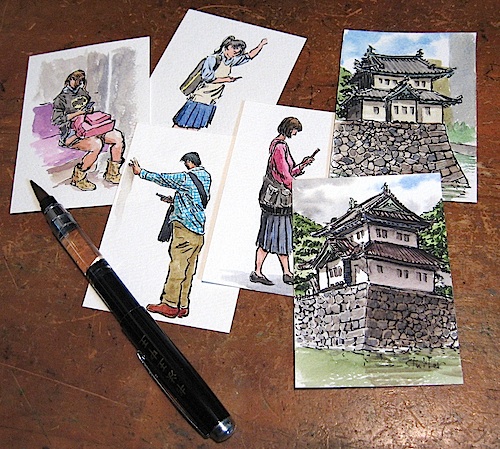 Here are a few trading card size sketches done on blank cards I cut out of regular sketch paper. The waterbrush is a small piston filler type from Blue Heron Arts. Because the piston takes up so much room, the water capacity is too small for regular size sketches but perfect for this format where you can make one or two sketches with one brush before it runs out of water. Other than the water capacity, these water brushes are actually nicer than the squeeze type because you have better control over the water flow. Mini Organizer Notebooks Here's an idea which combines the convenience of a sketchbook with the portability of small cards. They are called mini 6 ring binders, system notebooks and organizers, planners, or some combination of these names. These are very popular in Japan, and the standard paper size is 80mm X 126mm which is slightly wider than a 3X5 inch index card which would come out to 76.2 mm x 127mm. The Japanese company RayMay which produces the Davinci line of products makes their mini 6 pages 76mm x 126mm which is practically identical to 3X5 index cards and will fit an index card jotter. The spacing between the holes from center to center is the universal standard of 19mm which is used by western binder makers such as Filofax. The notebook below is a RayMay Davinci binder of green bonded leather in their "Just Fit" series which is narrower than standard mini 6 binders and will only accept the Davinci paper dimensions (76mm x 126mm). But I used cheap sketch paper which I trimmed down from a spiral bound sketchbook. Hole punches are also available. 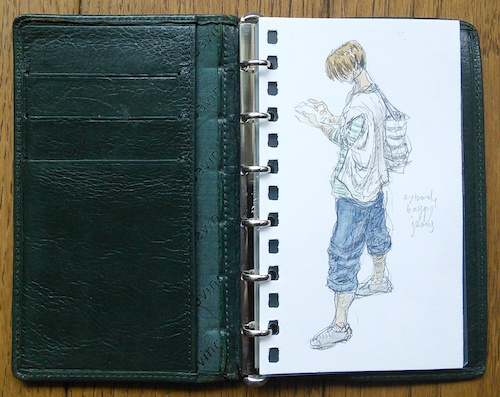 I can keep this notebook in my back pocket and whip it out when I see a subject. If the subject vanishes before I've made but a few squiggly lines, I can just throw away the page with no regrets and have a new page ready for my next subject. This system will help you to be a true sketch hunter, traveling light and ready to capture your subjects. I even have that quote by Robert Henri on the last page on my sketchbook. 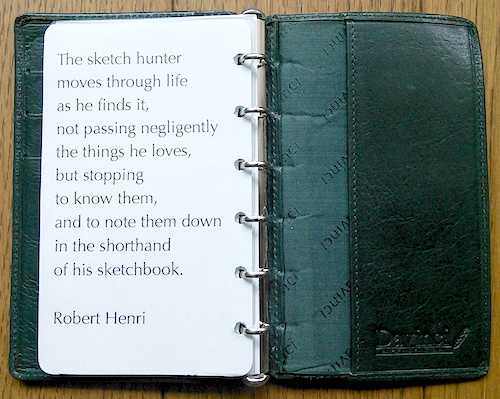
There are very inexpensive cardboard binders out there which are perfect for storing sketches on the book shelf. I can even bind the sketch pages with cord and some dark paper for a cover like an old-fashion Japanese bound book, as I did photo on the right. By the way, I made the round corners with a round corner punch After I move out the finished sketches, I can restock this notebook with blank pages, and keep a few of my very best sketches in the back of this notebook to show off to my friends. These pocket size ring binders have been around for many years. The trick is to find one slim enough for the pocket. Rounded corners also help a lot and will protect your jeans pockets more. 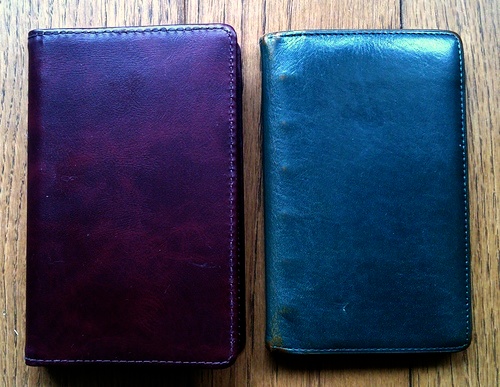 The smallest rings I have found are 8mm diameter, which make for a nice small notebook which fits the back pocket nicely, even jeans, and I've found two companies that have 8mm rings: Pilot 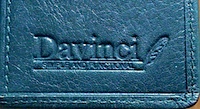
The Pilot is made of vinyl while the Davinci is real leather. I have both, having acquired the Pilot recently, but I prefer the feel of the leather Davinci notebook which is now several years old and well worn, and looks even nicer now than when new. Vinyl on the other hand doesn't age very well. And I love the Davinci name with the feather quill on the back inside cover. Very appropriate for a sketchbook, considering Leonardo's extensive use of sketchbooks as well. This next idea is probably one most people will not even think of trying, but I include it because it is so cool: a "vacuum formed" custom palette with six holes to fit in the notebook so I would be ready to paint every time I opened it.
You can't really see the cover in the photo to the right because when I'm using the palette, I close the cover back on itself, and tuck it out of the way under the palette. The surface of the cover which touches the paint still faces inward, so no paint accidentally gets transferred anywhere outside the cover. To keep the cover in place, I punched holes along the sides so it would attach to the rings. The holes on the bottom half (right half in the photo below) anchor the sheet to the notebook, and holes on the top half (left half in the photo below) have small slits so I can open it easily without unclasping the rings. It actually works well! I tried to take a photo to show exactly how it fits in the notebook, but photos of clear objects are difficult, so I also provided a diagram. 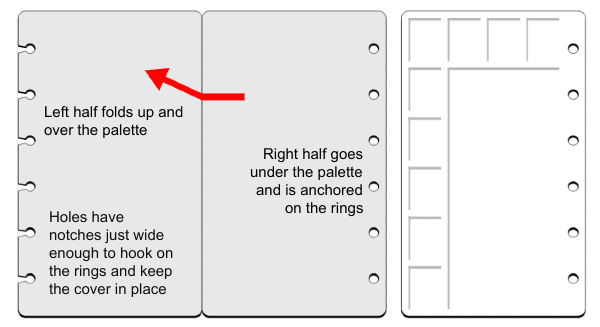 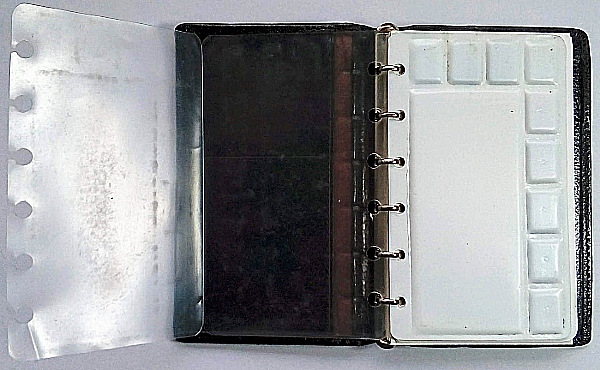 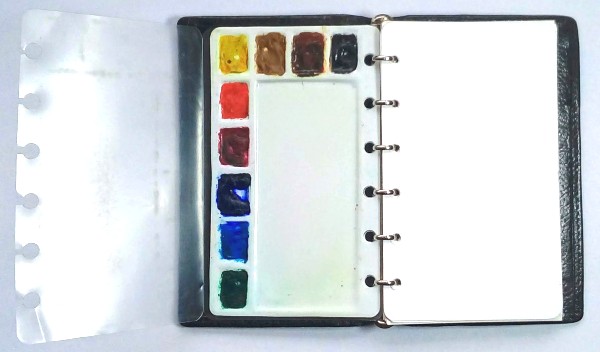 Here's another 6 ring binder with a palette made from plastic (polystyrene) sheets 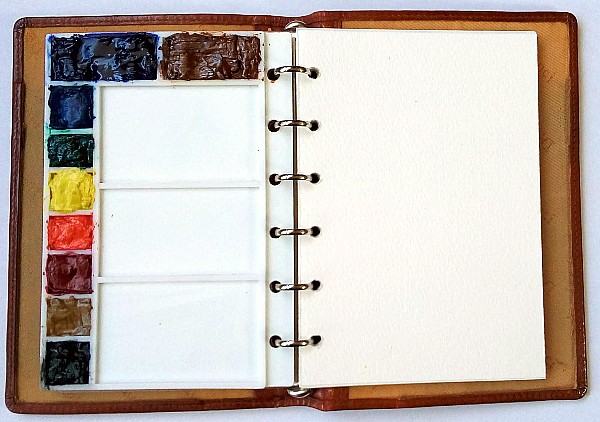 |
Next page >> |
 |
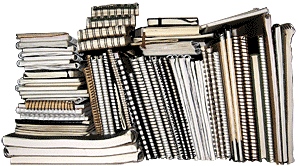 That sketchbook eventually was lost forever. On the other hand, over the years I have filled hundreds of cheap sketchbooks with all kinds of sketches, some good and some bad.
That sketchbook eventually was lost forever. On the other hand, over the years I have filled hundreds of cheap sketchbooks with all kinds of sketches, some good and some bad. 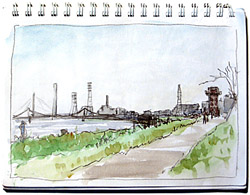
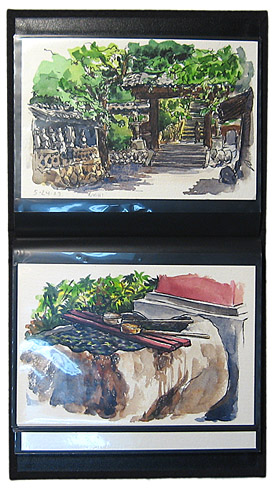 This makes for attractive sketches anyway, and is highly recommended.
This makes for attractive sketches anyway, and is highly recommended.
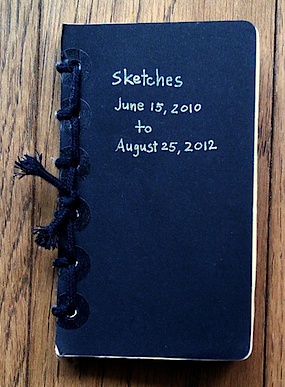 When I get back to my desk, I can move the finished sketches to another notebook for storage.
When I get back to my desk, I can move the finished sketches to another notebook for storage.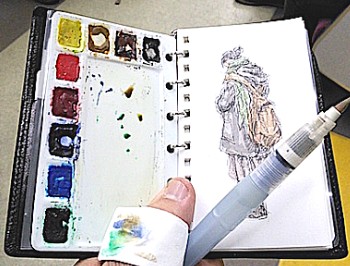 The trickiest part was coming up with a way to protect the pages from palette, and I stumbled upon a very simple idea: A cover made out of a sheet of thin plastic folded in half. I cut the plastic out of a clear soft plastic folder.
The trickiest part was coming up with a way to protect the pages from palette, and I stumbled upon a very simple idea: A cover made out of a sheet of thin plastic folded in half. I cut the plastic out of a clear soft plastic folder.